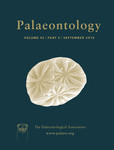Reg. Charity No. 1168330

Bats (Chiroptera) are one of the most successful extant mammalian orders, uniquely capable of powered flight and laryngeal echolocation. The timing and evidence for evolution of their novel adaptations have been difficult to ascertain from the fossil record due to chronological gaps and the fragmentary nature of most fossil bat material. Here, we quantify the quality of the bat fossil record using skeletal and character completeness metrics, which respectively document for each taxon what proportion of a complete skeleton is preserved, and the proportion of phylogenetic characters that can be scored. Completeness scores were collected for 441 valid fossil bat species in 167 genera from the Eocene to the Pleistocene. All metrics record similar temporal patterns: peak completeness in the Lutetian stage reflects the presence of Lagerstätten, while subsequent stages have very low completeness, except an Aquitanian high and a Pleistocene peak in skeletal completeness. Bat completeness is not correlated with intensity of sampling through geological time but has a weak negative correlation with publication date. There is no correlation between taxonomic richness and completeness, as the bat record predominately consists of diagnostic but isolated teeth. Consequently, bat skeletal completeness is the lowest of any previously assessed tetrapod group, but character completeness is similar to parareptiles and birds. Bats have significantly higher character completeness in the northern hemisphere, probably due to heightened historical interest and presence of Lagerstätten. Taxa derived from caves are more complete than those from fluviolacustrine and marine deposits, but do not preserve highly complete specimens.